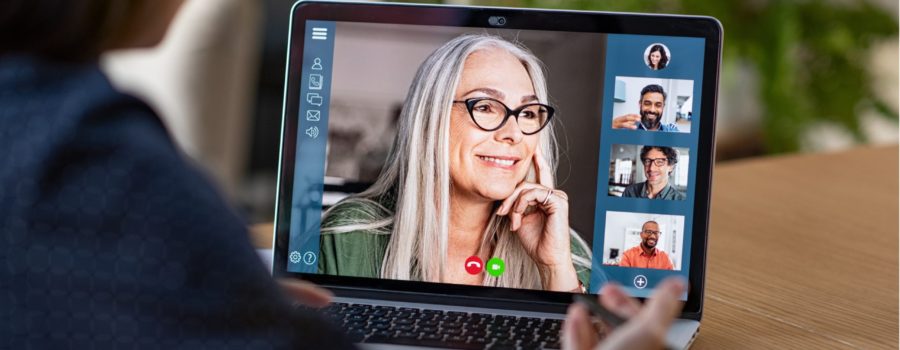Introduction
Hello! It’s Kristine here with the Express to Impress podcast.
Nowadays, conference calls are the norm. Whether your team members live within a 30-minute radius of one another or live on different continents, you’ll likely conduct all meetings over conference calls. By now, you know some of the potential perils of conference calls. Someone forgets to mute themselves, and you hear them breathing or eating their lunch, someone forgets to unmute themselves when they start talking, someone is talking, and then their kid or spouse barges in their office making noise. No matter what unusual situation unfolds during a conference call, someone has to manage the conversation and make it as effective as possible.
In this episode, you will learn how to lead conference calls. We’ll focus on audio conference calls, not video conference calls, which deserve their own episode.
Each week, I share stories and tips to help you communicate clearly and confidently in your job search, interviews, and the workplace so you can achieve your career goals. If you like my podcast, don’t forget to subscribe to get new episodes. You can subscribe anywhere you download podcasts like Apple, Pandora, or my website at express-to-impress.com.
Now, let’s begin!
Story
Now, I’ll tell you about a story about a conference call gone awry.
A friend in HR was leading a conference call when his girlfriend barged into the room. With a plate in one hand, she merrily announced, “Breakfast is ready!” immediately followed by the dirty nickname she has for her boyfriend.
My friend, of course, was stunned. His girlfriend was stunned. And yet, he had to continue leading the call, hoping, somehow, it would all blow over.
But he was leading the call, and he did not mute his call, so of course, his coworkers learned his dirty little name and other details about his personal life.
Since the others on the call muted their lines, any gasps or laughs were hidden from my friend. And fortunately, that was the end of it!
But he soldiered on, hoping his coworkers didn’t hear what they surely heard.
This is just one of many conference call horror stories. Saturday Night Live has a hilarious skit called “Zoom Call” that is undoubtedly inspired by some true events.
Now, there’s no need to worry about leading a conference call. We can all learn from funny mistakes. Let’s continue to the tips section, where you’ll learn how to lead a successful conference call.
What to Do Before You Lead Conference Calls
Your conference call will be productive and efficient with preparation.
Share an Agenda Before the Meeting
My first tip is to create an agenda and share it with all attendees before the meeting.
Master the Technology
Next, you need to master the technology you’ll be using. So, go ahead and test out Microsoft Teams, Zoom, or another tool you’ll use during the conference call. Ensure you know how the features work so you can take control of the meeting and help others if needed.
Prepare Your Environment
Finally, and most importantly, prepare your environment for the call. Tell your household members about the call, place a note on your door, lock the door, and do your best to ensure your environment will be as quiet as possible. That may mean putting your child down for a nap before the call or instructing your animal to enter their crate.
Tips for Leading Conference Calls
Now, let’s dive into how to lead a conference call.
Arrive Early
You’ll want to arrive early to ensure the technology is working correctly and welcome people to the call as they join. Your presence will also show the attendees that you’re prepared and in charge. You’ll also want to intervene before or during the call if someone has a bad connection or distracting noise in the background.
Open a Meeting
After some small talk with colleagues, you’ll want to get everyone’s attention to start the call. If your company culture is to start conference calls on the dot, be sure to start the call on time. If it’s normal to wait one or two minutes to allow for late joiners at your company, then give people that extra time.
So, to open a meeting, you should do the following:
- Get everyone’s attention
- Welcome and thank your audience for joining the call
- Introduce any new colleagues or visitors
- Explain the purpose and objectives of the meeting
- Outline the agenda
- Share expectations such as if people should mute their lines if they are not talking if they should use a tool to indicate that they have a question or comment in an online chat tool
- Ask the first person on the agenda to begin
Here’s an example of how you could open a meeting.
All right. It looks like most people have arrived. Rebecca’s on her way. She called to let us know that she’d be delayed but will be joining us soon. Let’s go ahead and get this show on the road.
Well, good afternoon, everyone. I want to welcome our visitor, Jane Doe from Corporate, to our call today. We’re delighted to have you with us today. The purpose of this call is to identify potential cuts. Let’s take a quick look at the agenda.
As you can see, the five department heads will be reporting on potential areas to cut in their departments. Each department head will be given 10 minutes to present, and then you’ll have a chance to ask them questions. Please ensure your line is muted unless you are presenting or asking a question. Any questions before we start? Great, let’s get down to business. Sam, can you start us off?
Discuss Issues
Now let’s look at your role while people are discussing issues.
Stick to the Agenda
When someone tries to change the topic, you have to bring them back to the agenda to keep the discussion on track.
You can guide the discussion back to the purpose of the meeting by acknowledging someone brought up a good point but that you need to bring the group back to the main point. Here, you can emphasize the benefit of staying on track by reassuring the audience that you know they are busy and want to get them out of the call on time.
Change the Topic
One of your most important roles is to monitor the time and interject when moving to a new topic. Sometimes, you’ll need to wrap up an urgent discussion as it’s unfolding. To do this, you can acknowledge it’s an important point and give some options for resolving it. The team can discuss it later in the call if there’s extra time, a follow-up call can be scheduled, or the conversation can continue by email after the conference call. Once you wrap up one topic, it’s time to direct the group’s attention to the next topic with a comment like:
Now, let’s give Seth our attention as he provides us with some updates about the IT Department.
Encourage Engagement
Widen the Discussion
You’ll be wearing a lot of hats in the conference call. One of them is engaging participants. If you notice some people haven’t contributed, you can pose a question like,
So, what do others think?
This sort of question will widen the discussion to include more people.
Check for Agreement
Progress requires making decisions, and as the conference call leader, you’ll need to check for agreement to reach decisions. So, how can you do that? You can ask if everyone is in agreement or simply ask if anyone disagrees or has concerns regarding plans being discussed.
End a Meeting
Eventually, it will be time to finish the meeting, and you’ll need to lead that process as well. In addition to indicating it’s time to finish up the meeting, restate agreements and follow-up items, and ask for final input.
Participants will appreciate you respecting their time, so be sure to wrap up on time.
Here’s how you could end a meeting.
Alright, I know you all have busy schedules, and I want to get you out of here on time. So let’s recap what we agreed on. We will move forward with cutting the low-hanging fruit from the budget, totaling $55,000. Then, we’ll revisit the budget in quarter four and see if any further cuts are needed. While focusing on eliminating only truly unnecessary costs, we’ll buy ourselves some time and not cause an uproar in the office. Does everyone agree?
Alright, now you know how to lead a conference call. You know what your responsibilities are and have some phrases to use at important points in conference calls.
INTERVIEW COACHING
Lately, I’ve been busy coaching 14 international doctors from Korea, Saudi Arabia, Peru, Taiwan, Palestine, and Turkey as they prepare for medical residency and fellowship interviews in the US. They are incredibly knowledgeable and accomplished, but interviewing in a second language is no easy feat. They impress me every day with their openness to learning and trying new ways of communicating to connect with their interviewers and convince them they would be successful in their programs.
If you have an interview coming up–either a job interview, medical residency interview, fellowship interview, or academic interview–I would love to work with you. I will help out with the content of your answers as well as the way you say your answers. I’ll also help you present the information concisely and impressively! After working together, you will arrive at interviews poised, confident, and prepared.
You can book a mock interview with me on my website at express-to-impress.com.
Tune in Next Week
Alright, I invite you to tune in next time to improve your English skills. You’ll learn definitions of phrases and idioms from this episode.
Thank you so much for listening to the Express to Impress podcast. If you liked this episode, please remember to share it with a friend! See you next time. Bye!
Music By Lucas Knutter







Leave a Reply
Your email is safe with me.